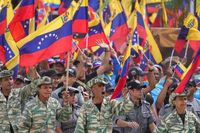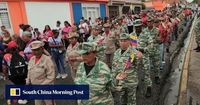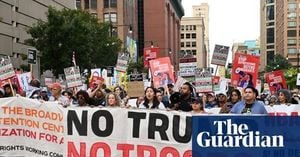On the bustling streets of Caracas, a palpable tension hangs in the air. Venezuelans, already accustomed to political drama, now find themselves at the epicenter of a rapidly escalating standoff between their president, Nicolás Maduro, and U.S. President Donald Trump. The latest flashpoint? Military maneuvers, threats of armed struggle, and a deadly strike at sea—each a piece in a high-stakes chess match that has the world watching and Venezuelans on edge.
According to CNN, the mood in the Venezuelan capital has grown increasingly anxious since September 6, 2025, as Maduro refuses to back down in the face of Trump’s mounting threats. But what exactly is driving this latest surge in hostilities?
The trigger, it seems, was a U.S. military strike on a boat in the Caribbean, which the Trump administration claims was operated by the Venezuelan drug gang Tren de Aragua. The U.S. government, which classifies Tren de Aragua as a foreign terrorist organization, announced that 11 suspects were killed in the operation. President Trump, never one to mince words, declared that the strike was a direct hit against “narcoterrorists” linked to Maduro’s regime—a claim Maduro vehemently rejects.
In a televised address on September 5, broadcast on all of Venezuela’s radio and television networks, Maduro warned, “We are currently in a political stage. But if Venezuela were attacked in any way, we would enter a stage of armed struggle.” He continued, “The government of the United States has to abandon its plan for a violent regime change in Venezuela and throughout Latin America and the Caribbean,” calling on Washington to respect the “sovereignty, right to peace and independence” of nations in the region.
The rhetoric has only intensified as military assets move closer to Venezuelan shores. The U.S. Department of Defense, according to multiple media reports, has ordered the deployment of 10 F-35 fighter jets to Puerto Rico, specifically to bolster efforts against drug cartels. These advanced aircraft are joining a growing flotilla of U.S. warships already stationed in the southern Caribbean. The Pentagon, as cited by Newsweek, stated that the Iwo Jima Amphibious Ready Group/22nd Marine Expeditionary Unit and the cruiser USS Lake Erie have joined destroyers USS Jason Dunham, USS Gravely, and USS Sampson in the region. The official line: these forces “will bolster U.S. capacity to detect, monitor, and disrupt illicit actors and activities that compromise the safety and prosperity” of the United States.
The deployment comes on the heels of a tense incident on September 4, when two Venezuelan military aircraft flew near a U.S. Navy ship in international waters. The Pentagon labeled this a “highly provocative move... designed to interfere with our counter narco-terror operations.” In response, Washington warned Venezuela not to make further attempts to hinder U.S. military operations against drugs.
Maduro, for his part, has dismissed the U.S. claims of drug trafficking as a “completely false case” fabricated to justify aggression against Venezuela. He insists that his administration is the victim of a smear campaign designed to pave the way for foreign intervention. “None of the differences we have and have had can lead to a military conflict,” he said on Friday, reaffirming Venezuela’s willingness to engage in dialogue but demanding respect from Washington.
Despite these calls for talks, the U.S. government remains steadfast in its opposition to Maduro, whom it has refused to recognize as Venezuela’s legitimate leader following disputed elections last year. The Trump administration continues to link Maduro’s government to narcotics trafficking and has signaled that further strikes—including possible attacks on suspected drug cartel targets inside Venezuela—are on the table, according to CNN.
The military disparity between the two nations is stark. As Newsweek reports, the U.S. boasts over 13,000 aircraft, compared to Venezuela’s modest fleet of 229, which includes Russian Su-30s, Iranian drones, and aging U.S.-made F-16s from the 1980s. From 2006 to 2011, Venezuela purchased 23 fighter jets, eight helicopters, 12 anti-aircraft missiles, and 44 surface-to-air missile systems from Russia, but experts say the Venezuelan armed forces struggle with collective training and command—making complex operations a challenge.
While Maduro claims he can call upon a force of 8 million Venezuelans in defense of the nation, the International Institute for Strategic Studies paints a different picture: 123,000 soldiers, 8,000 reservists, and 220,000 members of a civilian military arm. By contrast, the U.S. military counts more than 1.3 million active personnel and 800,000 reservists. Morale in the Venezuelan ranks is reportedly low, with high desertion rates and sluggish recruitment. Military spending tells a similar story—Venezuela’s defense budget was around $4 billion in 2023, down from $6.2 billion a decade earlier, a mere fraction of America’s $895 billion outlay, as noted by the Stockholm International Peace Research Institute and Global Firepower.
Yet, for all the saber-rattling, both leaders have signaled—at least publicly—a reluctance to push the standoff into outright war. “I respect Trump. None of the differences we’ve had can lead to a military conflict,” Maduro said, echoing his call for dialogue. But Trump’s stance remains firm: “If they do put us in a dangerous position, they’ll be shot down.”
For ordinary Venezuelans, the militarization of the Caribbean and the threat of conflict are a grim backdrop to daily life. The country is already grappling with economic hardship, political instability, and a humanitarian crisis that has sent millions fleeing across its borders. The prospect of armed confrontation with the world’s most powerful military only adds to the uncertainty.
As the U.S. continues to step up pressure—both militarily and diplomatically—on Maduro’s government, the risk of miscalculation grows. The deployment of advanced fighter jets and warships, the deadly skirmishes at sea, and the heated rhetoric from both sides have left the door open to escalation, even if neither leader appears eager for a full-blown war.
In the meantime, Maduro’s government is rallying supporters at home, with members of the National Bolivarian Militia gathering in cities like Valencia in response to his call to defend national sovereignty. The message is clear: Venezuela will not be cowed, but it is also not closing the door on dialogue—provided its sovereignty is respected.
As tensions simmer and the world watches, the question remains: Will cooler heads prevail, or are both nations inching ever closer to a confrontation that neither truly wants? For now, the people of Venezuela—and the broader region—can only wait and hope that diplomacy will win out over the drumbeat of war.






